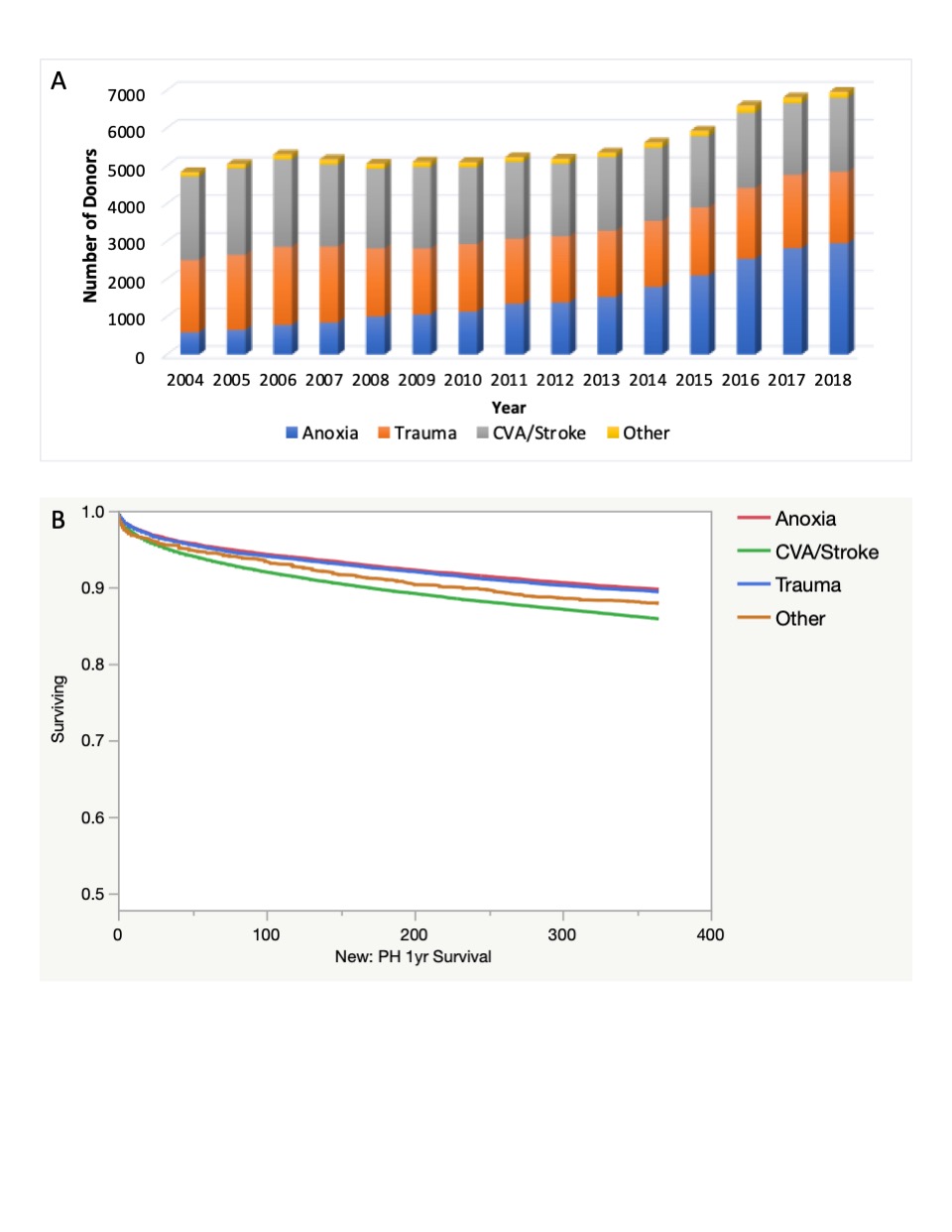Trends in Donor Cause of Death and the Effect on Outcomes in Liver Transplantation Over 15-Years
J. A. Steggerda1, I. K. Kim2, D. P. Ladner1, J. Caicedo1, D. Borja-Cacho1
1Transplant Surgery, Northwestern Memorial Hospital, Chicago, IL, 2Transplant Surgery, Cedars Sinai Medical Center, Los Angeles, CA
Meeting: 2022 American Transplant Congress
Abstract number: 1464
Keywords: Cadaveric organs, Donors, unrelated, Graft survival, Organ Selection/Allocation
Topic: Clinical Science » Liver » 62 - Liver: Large Data and Artificial Intelligence
Session Information
Session Time: 7:00pm-8:00pm
 Presentation Time: 7:00pm-8:00pm
Presentation Time: 7:00pm-8:00pm
Location: Hynes Halls C & D
*Purpose: Over the past 15 years, there has been a significant shift in donor cause of death (COD), which has coincided with an increase in liver transplantation (LT) in the United States. The present study examines the effects of donor COD on LT outcomes over this time period.
*Methods: The OPTN Standard Transplant Analysis and Research file was analyzed for LT occurring between 2004-2018. Exclusion criteria included recipients <18 years old, multi-visceral transplants, and prior LT recipients. Transplants were separated into three eras: 2004-2008, 2009-2013, and 2014-2018. Donor and recipient characteristics were evaluated by standard statistical analyses. Cox proportional hazards models were developed for 1-year graft loss; hazard ratios (HR) and 95% confidence intervals (CI) are reported. P-values <0.05 were considered significant.
*Results: Over the study period, 82,345 liver transplants were identified. Overall, cerebrovascular accident (CVA) or stroke was the most common COD (n=29,882, 36.3%) while trauma accounted for 27,817 (33.8%) donors and anoxia in 22,545 (27.4%). Donor death from anoxia increased significantly from 15.3% of donors in Era 1 to become the most common COD in Era 3, accounting for 38.2% of donors (Fig 1A). Donors with trauma and CVA/Stroke decreased over the study period, a trend seen in both brain dead (DBD) and donation after circulatory death (DCD) donors. Donor age was lowest for donors dying of trauma while body mass index was highest for those with anoxia COD (p<0.001 for both). Donors with trauma COD had lowest rates of hypertension (12.8%) and diabetes (3.9%) compared to anoxia (30.4% and 14.3%) or CVA/Stroke (61.3% and 16.0%, p<0.001 across all). Recipients of organs from donors with trauma COD had the highest mean MELD score (22.4±10.1) and were more likely to be mechanically ventilated (5.6%) and on dialysis (14.8%, p<0.001 for all). Multivariable modeling showed COD is significantly associated with 1-year graft loss (Fig 1B). Compared to anoxia, there was increased graft loss with trauma (HR 1.08, 95% CI 1.01-1.05) and CVA/Stroke (1.25, 1.19-1.34; p<0.001) as donor COD. This difference persisted in subgroup analysis of DBD donors; however, amongst DCD donors there was no difference in graft loss between donors with trauma and anoxia COD.
*Conclusions: Donor COD is a risk factor for graft loss that should be considered during donor selection. The opioid epidemic may increase the number of donors from anoxia and may contribute to improving outcomes in liver transplantation.
To cite this abstract in AMA style:
Steggerda JA, Kim IK, Ladner DP, Caicedo J, Borja-Cacho D. Trends in Donor Cause of Death and the Effect on Outcomes in Liver Transplantation Over 15-Years [abstract]. Am J Transplant. 2022; 22 (suppl 3). https://atcmeetingabstracts.com/abstract/trends-in-donor-cause-of-death-and-the-effect-on-outcomes-in-liver-transplantation-over-15-years/. Accessed December 27, 2025.« Back to 2022 American Transplant Congress

